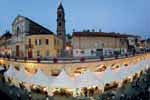The affordable Chianti
Hilly, lush and covered in vineyards, the Langhe region of Piedmont has culture, food and properties to rival Tuscany’s Chianti, but it is far more affordable


Among the foreigners who come here, most are wine aficionados on the Barolo trail, many are educated gourmets this is the birthplace of the Slow Food movement, which has its headquarters in the Langhe town of Bra several are literary, art and architectural buffs on the lookout for Baroque castles, medieval churches and the secret paths of the Langhe s Landscape and Literary Park, but only a relatively small number are second-home owners. The very first globetrotting buyers only started coming here in the 1980s and a few more followed in the past 10 years. Many are Germans and Swiss, who traditionally rented holiday homes here. But demand from Britain, the Netherlands and Scandinavia is on the rise, thanks partly to the Slow Food movement and the ensuing reputation of the Langhe gastronomy, and partly to the growth of the international airports in Turin, Milan, Genoa and Nice, all between 45 minutes and two hours drive away. Here people can enjoy the countryside and nature, with its relaxed rhythm, far from stress and in close contact with a straightforward, traditional and genuinely Italian culture, which is, at the same time and in the right measure, cosmopolitan and rich, says Luigi de Vico of local estate agent Gabetti Langhe. Add to this that the seaside and ski resorts are less than an hour away, and it s easy to see why international demand in the region looks poised to take off. As in Tuscany, Langhe buyers are chiefly looking for authentic villas and farmhouses in scenic countryside, preferably with a bit of land. Rustici, villas and cascine are the most sought-after properties among second home clients, says Mr de Vico. Interest is particularly strong for old rustici ripe for renovation, such as the sober stone houses that once belonged to Langhe farmers. The most intriguing have thick walls and rough wooden windows under a roof of flat, slightly irregular stones (the ciape), and are the vernacular counterpoint to the austere elegance of the area s medieval castles and the extravagant grandeur of its Baroque châteaux. These buildings share some architectural details with Chianti farmhouses first and foremost the wide use of stone, often left exposed, as the main building material but look and feel more rustic, if no less charming. In Chianti, however, rustici that haven t been restored are increasingly hard to find, and properly refurbished ones cost millions of Euros, so this has led to an increase in both supply and demand for smaller, more affordable homes often serviced flats or even fractional properties in sympathetically renovated hamlets. Many of the properties available in this market are medium to large and require a considerable upfront investment, explains a spokeswoman for the research department of Italian estate agent Tecnocasa. Today, buyers are usually developers who split the properties up into flats of about 70sq m to 150sq m, and sell them on. In Piedmont, by contrast, it s still possible to find unrenovated rustici and farmhouses as well as partially and fully renovated ones for a reasonable budget, particularly in the wild, wooded, more remote reaches of the Alta Langa. And this even more than a lush countryside, excellent wine and food, unusual architecture and rich history is what s starting to draw savvy international property buyers to this corner of the world. Although by no means cheap after all, Langhe is the preserve of well-heeled northern Italian professionals, intellectuals and entrepreneurs the region is still affordable. With the exception of established vineyards, which attract business as well as recreational interest and can easily reach into the millions of Euros, properties range from £160 to £242 per square metre (a rustico in need of complete renovation will, however, require an additional £800 to £1,000 per square metre for the work) to £1,400 to £3,200 per square metre (for a fully renovated cascina), according to Gabetti Langhe. Newly built villas can cost in the region of £1,200 to £2,400. Depending on the size, location and condition, prices start at 150,000 [about £120,000], says Real Estate Dreams Mr Fuerlinger. For a convenient, family sized, good rustico, you should calculate approximately 350,000 to 400,000 [about £281,000 to 321,000]. Italian agent Tecnocasa quotes similar figures for properties close to the villages of Nizza Monferrato, San Salvatore Monferrato and Canelli, and slightly higher ones for the area around the sought-after town of Alba, where rustici that have not been renovated cost at least 250,000 (about £201,000) and renovated ones 500,000 to 600,000 (about £402,000 to £482,000). Houses for sale in Tuscany This article was first published in Country Life International Summer 2008
Exquisite houses, the beauty of Nature, and how to get the most from your life, straight to your inbox.
Country Life is unlike any other magazine: the only glossy weekly on the newsstand and the only magazine that has been guest-edited by His Majesty The King not once, but twice. It is a celebration of modern rural life and all its diverse joys and pleasures — that was first published in Queen Victoria's Diamond Jubilee year. Our eclectic mixture of witty and informative content — from the most up-to-date property news and commentary and a coveted glimpse inside some of the UK's best houses and gardens, to gardening, the arts and interior design, written by experts in their field — still cannot be found in print or online, anywhere else.

